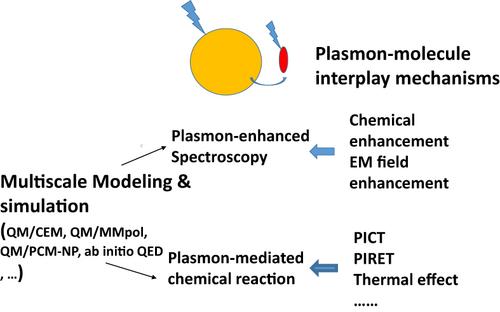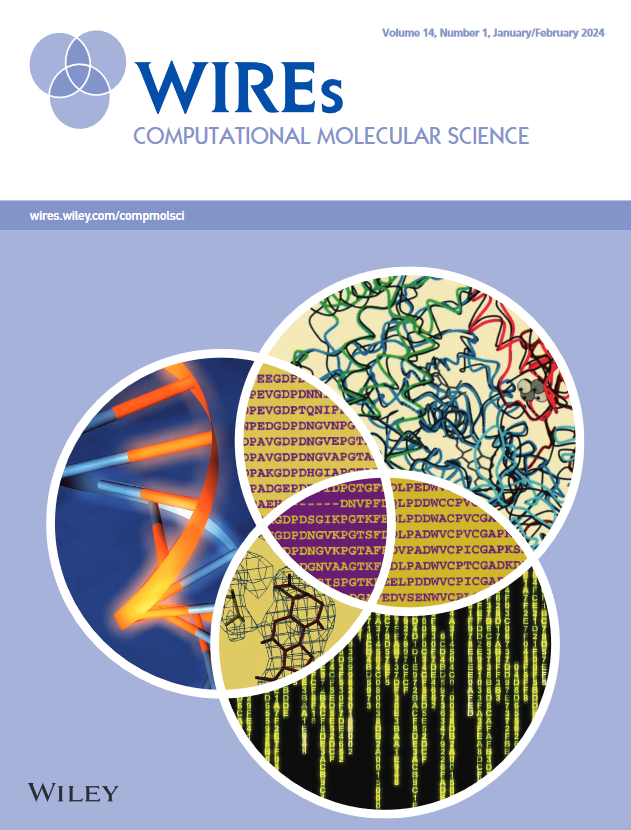Multiscale modeling and simulation of surface-enhanced spectroscopy and plasmonic photocatalysis
IF 16.8
2区 化学
Q1 CHEMISTRY, MULTIDISCIPLINARY
Wiley Interdisciplinary Reviews: Computational Molecular Science
Pub Date : 2023-05-02
DOI:10.1002/wcms.1665
引用次数: 0
Abstract
Plasmonic metal nanoparticles (PMNPs) are capable of localized surface plasmon resonance (LSPR) and have become an important component in many experimental settings, such as the surface‐enhanced spectroscopy and plasmonic photocatalysts, in which PMNPs are used to regulate the nearby molecular photophysical and photochemical behaviors by means of the complex interplay between the plasmon and molecular quantum transitions. Building computational models of these coupled plasmon‐molecule systems can help us better understand the bound molecular properties and reactivity, and make better decisions to design and control such systems. Ab initio modeling the nanosystem remains highly challenging. Many hybrid quantum‐classical (or ‐quantum) computing models have thus been developed to model the coupled systems, in which the molecular system of interest is designated as the quantum mechanical (QM) sub‐region and treated by the excited‐state electronic structure approaches such as the time‐dependent density functional theory (TDDFT), while the electromagnetic response of PMNPs is usually described using either a computational/classical electrodynamic (CED) model, polarizable continuum model(PCM), a polarizable molecular mechanics (MM) force field, or a collective of optical oscillators in QED model, leading to many hybrid approaches, such as QM/CED, QM/PCM, QM/MM or ab initio QED. In this review, we summarize recent advances in the development of these hybrid models as well as their advantages and limitations, with a specific emphasis on the TDDFT‐based approaches. Some numerical simulations on the plasmon‐enhanced absorption and Raman spectroscopy, plasmon‐driven water splitting reaction and interfacial electronic injection dynamics in dye‐sensitized solar cell are demonstrated.

表面增强光谱和等离子体光催化的多尺度建模与模拟
等离子体金属纳米颗粒(PMNP)能够进行局部表面等离子体共振(LSPR)并且已经成为许多实验环境中的重要组成部分,其中PMNP用于通过等离子体激元和分子量子跃迁之间的复杂相互作用来调节附近的分子光物理和光化学行为。建立这些耦合等离子体分子系统的计算模型可以帮助我们更好地了解结合分子的性质和反应性,并为设计和控制此类系统做出更好的决策。纳米系统的从头算建模仍然极具挑战性。因此,已经开发了许多混合量子经典(或量子)计算模型来对耦合系统进行建模,其中感兴趣的分子系统被指定为量子力学(QM)子区域,并通过激发态电子结构方法进行处理,例如时间相关密度泛函理论(TDDFT),而PMNP的电磁响应通常使用计算/经典电动力学(CED)模型、可极化连续体模型(PCM)、可极化分子力学(MM)力场或QED模型中的光学振荡器集合来描述,导致了许多混合方法,如QM/CED、QM/PCM、QM/MM或从头算QED。在这篇综述中,我们总结了这些混合模型的最新发展及其优势和局限性,特别强调了基于TDDFT的方法。对染料敏化太阳能电池中等离子体增强吸收和拉曼光谱、等离子体驱动的水分解反应和界面电子注入动力学进行了数值模拟。本文分类如下:
本文章由计算机程序翻译,如有差异,请以英文原文为准。
求助全文
约1分钟内获得全文
求助全文
来源期刊

Wiley Interdisciplinary Reviews: Computational Molecular Science
CHEMISTRY, MULTIDISCIPLINARY-MATHEMATICAL & COMPUTATIONAL BIOLOGY
CiteScore
28.90
自引率
1.80%
发文量
52
审稿时长
6-12 weeks
期刊介绍:
Computational molecular sciences harness the power of rigorous chemical and physical theories, employing computer-based modeling, specialized hardware, software development, algorithm design, and database management to explore and illuminate every facet of molecular sciences. These interdisciplinary approaches form a bridge between chemistry, biology, and materials sciences, establishing connections with adjacent application-driven fields in both chemistry and biology. WIREs Computational Molecular Science stands as a platform to comprehensively review and spotlight research from these dynamic and interconnected fields.
 求助内容:
求助内容: 应助结果提醒方式:
应助结果提醒方式:


